The experimental X-66 aircraft model with ultra-long wings has successfully completed its initial tests in a wind tunnel.
The experimental demonstrator model of the X-66A project, which NASA is developing in collaboration with Boeing, has successfully completed a series of tests in the wind tunnel.
2024-11-27 10:01:05https://naked-science.ru/community/1010404
Tests were conducted in a wind tunnel with a cross-section of 3.66 meters on a model of an aircraft with a wingspan of nearly 1.8 meters at the Langley Research Center in Virginia.
Experts measured lift and drag under various flight conditions.

The experimental aircraft of the X-66A project, developed to assist U.S. aviation in achieving net-zero greenhouse gas emissions, features a wingspan that is approximately 50% larger than that of a conventional airliner. This super-long wing has the potential to significantly reduce fuel consumption and set new standards for passenger aircraft.
Ground and flight tests for the X-66 are expected to commence in 2028.